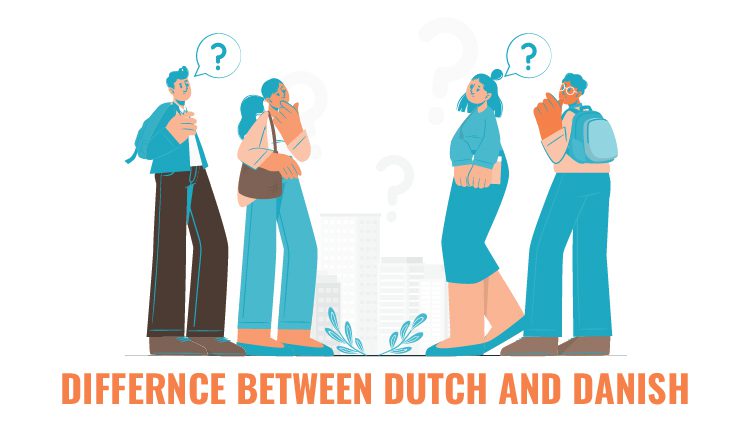
History and Background of Dutch and Danish
The history and background of Dutch and Danish is a fascinating topic that sheds light on the development of these two distinct languages. Dutch, classified as a West Germanic language, traces its roots back to the Low Countries, specifically the Netherlands and Belgium. With its origins dating back to the Middle Ages, Dutch has been shaped by various influences, including Germanic, Romance, and Celtic languages.
On the other hand, Danish is a North Germanic language, which places it in the same language family as Norwegian, Swedish, and Icelandic. The Danish language emerged in the Viking Age and has evolved over the centuries, incorporating influences from Low German, Middle Low German, and High German.
Both Dutch and Danish have played significant roles in history. Dutch was widely spoken during the Dutch Golden Age when the Netherlands was a major maritime power hub of trade and commerce. In contrast, Danish was told by the Danish people, who established successful Viking settlements and later formed the Kalmar Union, which united Denmark, Sweden, and Norway.
Dutch is also spoken in Suriname, Aruba, and parts of Belgium, while Danish is spoken in Greenland and the Faroe Islands. Despite their geographical proximity and shared Germanic origins, Dutch and Danish are distinct languages with unique grammatical structures, vocabulary, and pronunciation.
Understanding the history and background of Dutch and Danish provides valuable insights into the rich linguistic heritage of these European countries. Whether you're interested in the works of Dutch painters like Rembrandt or Danish authors like Hans Christian Andersen, learning about the history of these languages can enhance your appreciation of their cultural contributions.
Pronunciation and Alphabet Differences
Pronunciation and the alphabet play a crucial role in distinguishing Dutch from Danish. While both languages share some similar sounds, there are also distinct differences that set them apart.
Dutch and Danish use the Latin script in terms of the alphabet. However, Danish has three additional letters compared to Dutch: æ, ø, and å. These letters, known as "vowels with diacritics," represent specific sounds unique to Danish. The letter æ, for example, is pronounced as a combination of the sounds "eh" and "ee." On the other hand, Dutch does not use these additional letters in its standard alphabet.
In terms of pronunciation, both languages have their nuances. Danish is known for its "stød," a glottal stop sound in certain words and syllables. This sound is absent in Dutch, making the pronunciation distinctly different. Additionally, Danish pronunciation tends to have a softer, more melodic quality compared to Dutch, which has a slightly harsher sound.
It's worth noting that both languages have variations in pronunciation within different regions or accents. For example, a Danish person from Copenhagen may have a foreign accent compared to someone from Aarhus. Similarly, a Dutch speaker from Amsterdam may have a different accent than someone from Rotterdam. These regional differences further contribute to the diversity of pronunciation within each language.
Understanding the pronunciation and alphabet differences between Dutch and Danish is crucial for effective communication. It allows for clearer and more accurate spoken interactions and helps develop a more authentic and native-like fluency in either language.
Grammar and Vocabulary Variations
One key aspect distinguishing Dutch from Danish is the differences in grammar and vocabulary. While both languages have a Germanic foundation, they have developed unique structures and word choices.
In terms of grammar, Dutch and Danish have distinct features. Dutch has a complex system of verb conjugations and noun declensions, similar to English and other Germanic languages. On the other hand, Danish has a simpler grammar structure, with fewer verb forms and noun declensions.
The vocabulary of Dutch and Danish also varies significantly. Various languages, including French, Spanish, and English, have influenced Dutch throughout history. As a result, many Dutch words have counterparts or similar meanings in English. Learning Dutch vocabulary can become more accessible for English speakers through this approach.
On the other hand, Danish vocabulary is strongly tied to other Scandinavian languages, such as Norwegian and Swedish. While there may be some similarities with English words, Danish vocabulary often has unique words and expressions that require more effort for an English speaker to learn.
Additionally, the differences in vocabulary extend to specific terms related to daily life and cultural contexts. For example, the Dutch city of Amsterdam has a unique vocabulary that may differ from the Danish city of Copenhagen. Similarly, terms of language related to food, transportation, and greetings can vary between Dutch and Danish.
Understanding the grammar and vocabulary variations between Dutch and Danish is essential for effective communication and language learning. By recognizing the distinct features of each language, English speakers can better navigate the intricacies of Dutch and Danish and develop fluency in either language.
Cultural Differences between the Netherlands and Denmark
When comparing the Netherlands and Denmark, it's important to note that they have unique cultures and customs. The cultural differences between the Netherlands and Denmark can be seen in various aspects of daily life.
The Netherlands, known for its tulips, windmills, and cycling culture, has a reputation for being laid-back and liberal. The Dutch are known for their directness and open-mindedness, making it easy for foreigners to adapt and feel welcome. The Dutch also value individualism and personal freedom, and their society is known for its tolerance and acceptance.
On the other hand, Denmark, a Scandinavian country, strongly emphasizes equality, welfare, and community. The Danish people are known for their hygge, a concept of coziness and contentment. Danes prioritize work-life balance and highlight spending time with family and friends. They have a strong sense of community and social welfare, with a well-developed welfare system.
Both countries have a high proficiency in English, with a large percentage of the population being fluent in English. This makes it easier for English speakers to communicate and navigate daily life in either country. However, it's always beneficial to learn the local language, Dutch or Danish, as it shows respect for the culture and helps integrate into the local community.
Overall, the cultural differences between the Netherlands and Denmark provide a rich and diverse experience for visitors or those looking to learn the Dutch or Danish language. Whether you're drawn to the laid-back and liberal nature of the Netherlands or Denmark's cozy and community-oriented lifestyle, both countries offer unique cultural experiences that can enrich your understanding of the world.
Examples of Common Phrases in Dutch and Danish
Now that we've covered the history, pronunciation, grammar, and cultural differences between Dutch and Danish, let's dive into some common phrases. Whether planning a trip to the Netherlands or Denmark or wanting to impress your Dutch or Danish friends, learning keywords can go a long way in making connections and showing interest in their language and culture.
In Dutch, here are some essential phrases to get you started:
- "Hallo" - hello
- "Bedankt" - thank you
- "Hoe gaat het?" - how are you?
- "Ik begrijp het niet" - I don't understand
- "Waar is het toilet?" - where is the toilet?
- "Mag ik de rekening?" - can I have the bill?
In Danish, try these phrases to impress the locals:
- "Hej" - hello
- "Tak" - thank you
- "Hvordan har du det?" - how are you?
- "Jeg forstår ikke" - I don't understand
- "Hvor er toilettet?" - where is the toilet?
- "Kan jeg få regningen?" - can I have the bill?
Practice these phrases with a native speaker or use language learning apps to perfect your pronunciation. Don't be afraid to make mistakes, as natives will appreciate your efforts to communicate in their language. Learning these common phrases will make your travels more enjoyable and show respect for the local culture and people. So, go ahead and start speaking Dutch or Danish with confidence!
Dutch or Danish: A Beginner's Guide to Choosing the Easier Language
Learning a new language can be both exciting and challenging. You may wonder which is easier to understand when comparing Dutch and Danish. Danish and Dutch languages have unique features and complexities, making it difficult to determine a definitive answer.
Dutch is known for its complex grammar and vocabulary, similar to English and other Germanic languages. This can be challenging for English speakers, but at the same time, the shared Germanic roots can also make learning Dutch somewhat easier. Many Dutch words have counterparts or similar meanings in English, which can provide a helpful starting point for language learners.
On the other hand, Danish has a simpler grammar structure with fewer verb forms and noun declensions. However, Danish pronunciation can be tricky for English speakers due to its unique sounds and intonation patterns. Danish also has a smaller pool of resources available for language learning than Dutch, which may be difficult for learners.
Ultimately, the ease of learning Dutch or Danish will depend on your personal background, language learning experience, and motivation. Both languages have challenges, but with dedication and practice, you can achieve fluency in either language. So, whether you learn Dutch or Danish, embrace the journey and enjoy exploring a new language and culture.
Frequently Asked Questions
There are numerous online courses, apps, and textbooks available for learning Dutch and Danish. Language schools and cultural centers also often offer classes and resources for those interested in mastering these languages.
Sure! For example, the word "apple" in Dutch is "appel," while in Danish, it's "æble." These differences extend to many everyday words.
Due to their linguistic similarities, Swedes and Norwegians can often understand each other. Written communication is usually easier to comprehend than spoken conversation.
Despite their differences, both languages share some commonalities with Germanic languages. They may have some similar words and grammatical features.
https://www.universal-translation-services.com/the-key-differences-between-dutch-and-danish/


Comments
Post a Comment